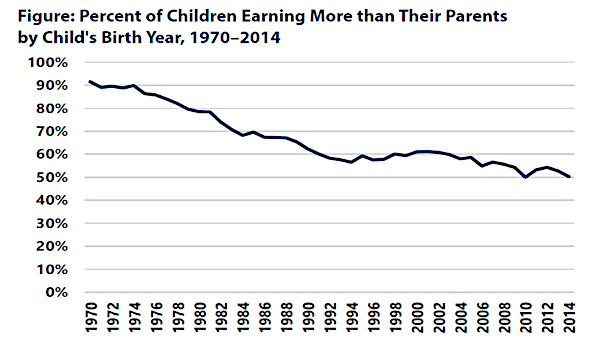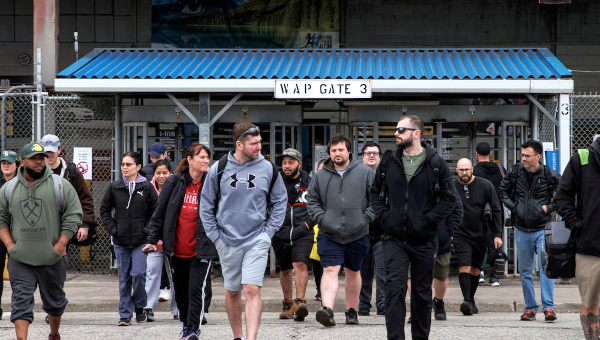Complex Challenges Require Radical Responses: Confronting Trump’s Tariffs
Robert Chernomas and Fred Wilson, in their SP Bullet of October 24th, “Beyond the ‘Elbows Up’ Response to the Tariff War,” call for a “national industrial policy” strategy to respond to the economic challenges posed by the tariffs imposed on Canada by US President Donald Trump. They argue for a set of policies to challenge the integration and dependence on the US in ways that also address some of the impacts of neoliberalism. Their strategy calls out and identifies the weaknesses in Prime Minster Mark Carney’s policies; it is a positive contribution alongside others in a similar vein.1 But there are also certain limits that need to be raised for the challenges that lay ahead for the union and socialist movements in Canada.
The authors take as their inspiration the Canadian and US responses to the turmoil of the Great Depression and World War II period. Referencing the national mobilization efforts to those emergencies and some of the policy approaches is helpful history, but the references to Canadian Prime Minister Mackenzie King’s and US President Franklin Roosevelt’s New Deals are of limited relevance for today in this distinctive neoliberal period.

Historical Models and Lessons To Be Learned
The stagnation of the depression era and the subsequent war effort signaled a change in the approach of the capitalist state and classes. But the fundamental purposes of such policies in both the US and here in Canada, were to restore the international trading order, not delinking from it; addressing stagnation and restoring capital accumulation, and responding to the massive movements demanding jobs, incomes and peace. This included the growth of political parties, unions and social movements critical of capitalism entire, and that were important to the general mobilization to defeat the Axis powers in World War II.
Many of the policy changes called for state incentive and regulatory approaches to private capital, but they also included the creation of crown corporations for the war effort and rebuilding the capitalist economy. This was done in ways that reflected a necessary relative autonomy of the state to restore political legitimacy to the system as well as address the stagnating profits and capital accumulation. This need for legitimacy was expressed in the so-called postwar Golden Age of capitalism in the development of the Keynesian Welfare State. This social and economic policy regime expressed the interests of the capitalist class as a whole, and had the support of key business groups and a majority of the liberal intellectual and policy leaders of the liberal democratic capitalist system.
While the series of supply-side policy reforms called for by Chernomas and Wilson should be part of discussions on the left, the reforms do not address the kinds of transformations needed to create a new ‘care’ economy, and industrial transformation on an ecological basis, nor how these can be accomplished within the constraints of Canada’s capitalist economy. In the era of neoliberalism, the capitalist class has fixated on increasing competitiveness and deepening economic integration with the US, notably in the spheres of AI, energy transitions, austerity, and massive investments in the military.
When the Keynesian era ended, in Canada it also took with it any notion of a structural coordinating industrial policy. Government policies, institutional capacities and structures, and strategies for economic growth adopted the market-centred strategies of neoliberalism. The lessons learned and the policies formed by the Canadian state and capital make it suspect to argue that business, investment, and the neoliberal state can be pressured to revert to strategic approach of an earlier era. This is a severe limit to many policy reforms and social democratic approaches, no matter if they are positive reforms, in this political-economic conjuncture.
Arguing for a state-led industrial policy doesn’t ask and answer where this political leadership and such a program might form after decades of neoliberal policy, and the same questions can be posed for the role of private capital and its goals. It is a hard fact that Canadian capital, both national capital blocs and foreign capital internalized in the Canadian state, opposed even the most modest set of industrial policies in the past and continue to oppose such policies today (apart from large state subsidies without strings). This includes the opposition of almost all Canadian capitalist organizations, large and small, to increasing taxes on the wealthy, mass social housing, reduction on reliance on resource exports and expansion of value-added linkages through state controls over royalties, and so on. If an ambitious goal of, as the authors put it, “a coherent industrial national policy that would be transformative of the whole economy, by adding value and meeting social and environmental goals,” is needed, the political and organizational conditions for this project need to be created. Can these conditions evolve without a mass anti-capitalist political project and a revived union movement?
‘Progressive Competitiveness’: Not Progressive and Not a Solution
Chenomas and Wilson veer away from raising structural reforms that would challenge capital’s power: taking over and democratically controlling and directing finance, capital controls, state ownership of key sectors, transformation of the economy to include democratic planning, and the massive conversion needed to build an eco-socialist economic and political target. These struggles for controls over capital and production for social needs, not market exchange and profits, are subversive of the underlying acceptance of the private sector’s economic dominance and overall dependence on private capital accumulation, competitiveness and business confidence. This includes, of course, the continued integration of Canada as the most reliable ally to the US empire’s global framework. The various ecological, economic and geopolitical crises give an urgency to building a vision and movement that would take up such an agenda. Political options are polarizing and the room for modest reforms is closing. This is the central signal of the policies and movements behind the Trump regime after the failures of the Biden Administration.
Such a project can’t unfold overnight, of course, especially without a socialist politics to win over working people and a political movement that could argue for the kind of transformation needed. Any reforms argued for will exist in the context of an ongoing capitalist economy, integrated into the US-led global economic system, and remaining dependent on private-sector lending and investment. These political constraints need to be taken into account in any proposal for a ‘state-led national industrial policy’.
The Biden administration’s policies are invoked as a positive example of what they would call for in Canada. The authors write, “The US became the envy of the industrialized world with respect to GDP growth, prices stability, full employment, real wage increases and an enthusiastic stock market as it revived its manufacturing sector from one of the country to the other building a green economy. And it was just getting started.” But the Biden policies were and are problematic and an example of relying on private sector actors that are incentivized and partially financed by state policy goals for a “green and care economy.”

These policies represented the hopes of American progressives for an exit from neoliberalism and American finance capital hegemony. The policies initiated a few successful experiments, but fell far short of igniting the transformative processes promised by the Biden Administration. They are likely to equally fall far short of what the authors, and indeed the left in Canada, are seeking and needing. Notably, the Biden program failed to convince a majority working-class bloc that it represented a viable alternative for their communities to the market-centred politics that inhabits almost all corners of the Democratic Party. This failure and continuing fracturing of working-class politics in the US did not eliminate but rather prepared the base for the right-wing populist agenda of Trump’s MAGA movement, and with it, the chauvinistic and aggressive nationalism that backs the tariff policies and politics as industrial policy. The Democratic Party and the Biden policies are floundering in the far margins of the US state.
This was more than a failed social democratic moment. It was hailed by the Democrats and their supporters as a centrist solution to the on-the-ground challenges that working people in rural and de-industrializing areas have been living with in the neoliberal era. The Biden Plan failed, however, to address the conditions of massive inequality, declining incomes, joblessness and insecurity that characterize the realities of much working-class life. These failings reinforced the strength of the message of the populist right. Across the capitalist world today, there are no middle-ground options. This is a central reason for the crisis and decline of social democracy since its embrace of the ‘Third Way’, in the Florence Accord of the late 1990s, which represented the incorporation of social democracy into neoliberal policy frameworks. The Biden recipe confronts even greater obstacles as an alternative in Canada (where the Canadian Liberal Party has been a bulwark for neoliberal policies).
Demands for even moderate transformations today need to move beyond a framework of using the state to stimulate private sector competitiveness in critical areas of social and economic development. As the left and unions steadily learned across the 1990s, the discourse of creating a stronger and more competitive capitalist economy falls into the trap of searching for a ‘progressive competitiveness’. Rather than maintaining worker and union organizational independence to take political actions as needed, and to develop a worker-centred program form of intervention in workplaces, this project easily slides into the illusions of a ‘competitive corporatism’ binding workers to their companies and supporting the internationalization of capital. Without a strategic autonomy for working-class movements, there is little room to take steps to beyond the employer’s agenda. And a distance yet to be travelled to build a vision and practice of workers’ control and production, as need is essential to alternatives to capitalist markets.
Chernomas and Wilson are right to argue for an alternative to the Carney agenda and the return to austerity in Canada to buttress a massive increase in defence spending and infrastructure and subsidies for corporations. They contribute to a growing discussion within the broad left in Canada (and indeed around the world) about how to lessen dependence on the US. This is necessary for building on historical efforts at economic and political reforms that focus on economic and social security and human development for all. This is integral to their call for a ‘national industrial policy’ that deepens state capacities in key sectors to “direct production and supply chains, as well as ordering, where needed, disinvestment and securing Canadian ownership and control.”
But does Canadian ownership and control of private corporations or finance mean contributing to Canadian economic competitiveness that does not foremost benefit private investors? Are Canadian-owned corporations any different in their intensification of labour in workplace in pursuing the internationalization of their capital investments? Is choosing sides in the nationality of capital really our goal? Meaningful democratic sovereignty means using the collective capacities of working people to build an alternative for transforming the economy, healing the environment, eliminating fossil fuel dependence and deepening social rights, in conjunction with aboriginal peoples.
That requires rebuilding a socialist movement and encouraging a vast array of experiments in collective or public ownership, community-owned enterprises,2 and a break from the corporate competitiveness and endless commodification that still haunts much of what passes for national industrial policy. Forming links of international solidarity with others also fighting against Trump’s economic policies and tariffs is also part of the new political terrain that we now confront. This is the ambition we once had and need to re-find. •
Endnotes
- See: “Elbows Up: A Practical program for Canadian Sovereignty,” CCPA, October 30, 2025; Jim Stanford, “Building a Sovereign, Value-Added and Sustainable Economy A Factbook for the ‘Elbows Up Economic Summit’,” CCPA, August 18, 2025; and Fred Wilson, “Progressive Nationalism and the Fight for Canadian Sovereignty,” Canadian Dimension, September 8, 2025.
- An example was the movement called Green Jobs Oshawa, which argued and organized for a conversion of the threatened General Motors Oshawa factory complex into a producer of green vehicles for public and collective uses, and creation of a hub for experimentation of new green transportation needs.






